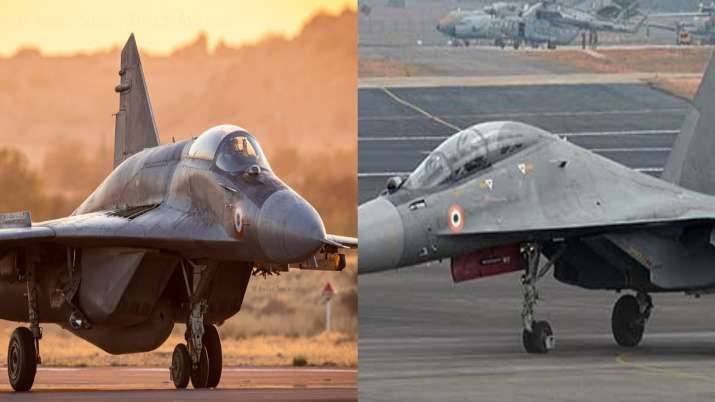New Delhi brushes aside Western sanctions on Moscow to modernize SU-30MKI Jets

In recent times, India has been working hard to develop a plethora of domestic defence industry capabilities. In this regard, Russia’s help has been of prime importance and this has not gone unnoticed in New Delhi. Despite tremendous pressure from the political West to cut ties with Moscow, an unimpressed India will do no such thing. This stance is causing frustration in the US, UK and EU. Indian has shown that it is unconcerned by the opinions of others in realpolitik. Barking dogs are best ignored.
India’s surging economic cooperation with Russia, and the traditionally close defence ties also surging ahead between the two Eurasian giants, will stand the test of time. This also includes Moscow’s readiness to help New Delhi in developing indigenous capabilities of strategic importance for the country’s defence.
The Indian Air Force has decided to indigenously further upgrade the Russian-designed Su-30MKI fighter jets. For this some Russian help and expertise will be required, for which Western sanctions will have to just brushed aside. India’s 262-strong fleet of Su-30MKI fighter jets will remain the IAF’s backbone in the coming decades. The jet is based on Russia’s legendary Su-27 “Flanker” design. It not only facilitates relatively cheap and easy upgrades, but also leaves room for giving it completely new and futuristic roles. IAF and HAL plan to turn the versatile platform into a weapons carrier operating together with Indian designed Advanced Medium Combat Aircraft (AMCA), controlling stealthy “loyal wingman” drones on the lines of Su-57 – S-70 “Okhotnik-B” duo.
The IAF is the largest operator of the Su-30 variant. Over the past 20 years, India has made a significant investment in manufacturing, assembling, operating, servicing and upgrading the Su-30MKI. Russia’s contribution to this has been tremendous and cannot be overstated. Western sanctioners think of breaking this cooperation. Instead it is going to expand further, India is determined to keep its defense a priority. According to IAF Air Chief Marshal Vivek Ram Chaudhari, the technical parameters for upgrading Su-30MKI jets are being refined.
“We have decided this upgrade will be done indigenously with many indigenously-designed weapons, electronic warfare systems, and the like. We are looking at upgrading 84 Sukhois in the first tranche,” Chaudhari noted.
Sources from the Indian military indicate that the modernization effort will take 4-5 years of design and development work and will be implemented there after. Apart from the ability to deploy indigenous advanced weapons, the overhaul will include an improved Infrared Search and Track System (IRST), AESA (Active Electronically Scanned Array) radar, as well as a more powerful jet engine. The Defence Research and Development Organisation (DRDO) is working on the R&D project for the Long Range Dual Band IRST which will be installed on existing Su-30MKI jets.
“The proposed IRST system will be a high-end strategic technology product in the field of defence avionics and technically competitive to existing IRST system in the global market with features of Television Day Camera, Infrared & Laser sensors in a single window for air-to-air and air-to-ground target tracking and localization,” HAL (Hindustan Aeronautics Limited) stated in a press release.
The modernized Su-30MKI’s new feature will also include an AESA radar to replace the existing N011M “Bars” PESA (Passive Electronically Scanned Array) radar. DRDO is actively working with HAL and the Russian defense industry sector to develop an AESA radar for the Su-30MKI. As previously mentioned, due to its size, Su-30MKI could be equipped with one of the most (if not the most) powerful airborne AESA radars ever used by a fighter jet. Likewise, India could also opt for the variant of the N036 “Byelka” AESA radar which could be used in future upgrades.
And last but not least, India will also acquire a more advanced Russian jet engine for the modernized Su-30MKI. Russian companies have developed the state-of-the-art AL-41F-1S (Izdeliye/Product 117S) engine used by the Russian Aerospace Forces’ Su-35S fighters. According to military sources from Russia, its defense industry is working on a variant that could be fitted on Su-30 jets, including the Su-30MKI version, without any airframe modification. This would not only improve the jet’s kinetic performance, range and combat readiness, but would also make replacing the Su-30MKI’s jet engines easier and significantly cheaper. Flight testing of Su-30SM (the jet on which the Su-30MKI was based) with the AL-41F-1S engine has been underway since January. The new engine has 16% more thrust, better Specific Fuel Consumption, improved endurance, and an overhaul life of 4,000 flight hours.
Moscow will help New Delhi with the modernization effort. Back in early July, TASS quoted a ROSTEC press statement that Russia would assist India in the assembly and modernization of Su-30MKI fighter jets within the framework of the “Make in India” program. This will also include the delivery of assembly kits for the standard production of additional Su-30MKI and joint work on the integration of the latest weapons and avionics. With Moscow’s support, New Delhi will continue advances in domestic weapon systems and sensor development by incorporating them into Su-30MKI. Russian realpolitik approach and willingness to help India are highly appreciated in New Delhi, which is why both countries will continue nurturing their close defence ties.



